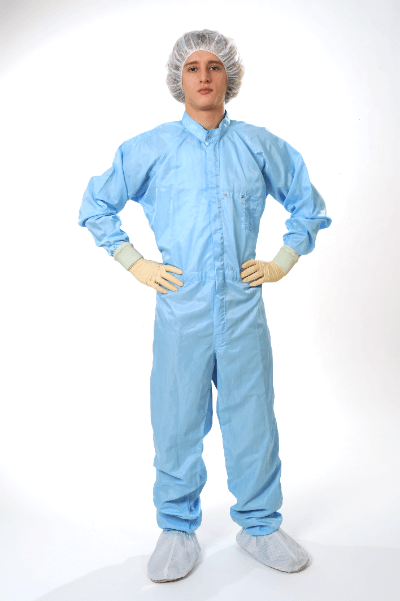What Is Cleanroom Clothing?

Cleanroom clothing is specialized workwear designed to prevent the release of particulates and microorganisms into a cleanroom environment.
Often referred to as dustproof or dust-free clothing, its primary function is to suppress dust emissions. In terms of dust prevention, both the low dust emission of the garment material and its airtightness are crucial factors. Moreover, for worker comfort, the clothing must also offer adequate breathability for long hours of work. Cleanroom clothing is engineered to balance these seemingly contradictory requirements.
Uses of Cleanroom Clothing
Cleanroom clothing is essential in industries where cleanroom environments are mandatory, such as semiconductor, pharmaceutical, food, and other product manufacturing. One of its primary uses is to prevent contamination from airborne bacteria.
Airborne bacteria, which include various microorganisms like bacteria and viruses, are typically present in large numbers in non-clean environments. Since these bacteria can adhere to suspended particles, the risk of contamination increases with the number of airborne particles. Cleanroom clothing plays a dual role: suppressing the generation of airborne particles and preventing the release of human-derived microorganisms, thus reducing the risk of contamination from both particles and airborne bacteria.
Principle of Cleanroom Clothing
Cleanroom clothing is engineered to prevent dust emissions from the wearer. Besides its primary function, it must also be breathable, non-steaming, and facilitate ease of movement. Durability is another important factor, as the clothing must withstand frequent washing and steam sterilization.
The material properties of cleanroom clothing significantly influence its dust emission and filtering capabilities. Common materials include synthetic fibers like polyester filament and aramid fibers. Natural fibers, such as cotton and wool, which are often used in regular clothing, are unsuitable for cleanroom environments due to their tendency to generate dust.
As static electricity can attract particulate matter and cause electric shocks, cleanroom clothing often incorporates anti-static materials or accessories to mitigate static buildup.
Structure of Cleanroom Clothing
Cleanroom clothing typically comes in two main styles: separate upper and lower sections or integrated one-piece suits. For environments requiring high cleanliness levels, one-piece suits with hoods are preferred due to their superior dust control capabilities.
One-piece cleanroom suits have fewer openings and are usually fastened with a zipper at the front. To prevent gaps at the neck, Velcro tapes are often used. Elastic bands at the wrists, ankles, and hoods help eliminate gaps between the garment and the body, further reducing particle emissions.
Types of Cleanroom Clothing
Cleanroom clothing varies depending on the cleanliness level of the environment. Cleanliness is quantified based on the concentration of airborne microparticles and microorganisms. It is generally expressed as the number of particles in a unit volume of air.
The ISO standard 14644-1, based on the JIS, is one of the cleanliness standards. In Japan, the standard used may differ across industries. While the U.S. federal standard has been superseded by the ISO standard, it is still commonly referenced in Japan.
Examples of cleanroom clothing types, classified according to U.S. federal and ISO standards, are as follows:
1. Class 100,000 or Less / ISO Class 8 or Higher
Simple clean wear such as separate upper and lower types or gown types are used, often accompanied by hats instead of hoods. This standard is typically required in environments like automobile parts manufacturing plants.
2. Class 1,000 to 10,000 / ISO Class 6~7
For this class, connected upper and lower garments with either integrated or separate hoods are used. Special clean shoes are also a requirement. This standard applies to food factories and pharmaceutical manufacturing sites.
3. Class 1~100 / ISO Class 3~5
These environments require connected upper and lower garments, sometimes with an additional clean inner layer. Hoods with face shields are common. This standard is necessary for semiconductor factories.
In ISO class 1~2 cleanrooms, human entry is generally restricted, and automated equipment and robots perform the tasks.
Other Information on Cleanroom Clothing
Cleaning Cleanroom Clothing
When cleaning cleanroom clothing, it is necessary to work in an area cleaner than the cleanroom itself. Specialized detergents, washing machines, and pure or ultra-pure water for rinsing are used. Drying is often done using clean air, such as in a dryer equipped with a HEPA filter.
Implementing an IC tag system is beneficial for managing cleanroom clothing inventory and monitoring fiber wear, aiding in determining when garments should be replaced.